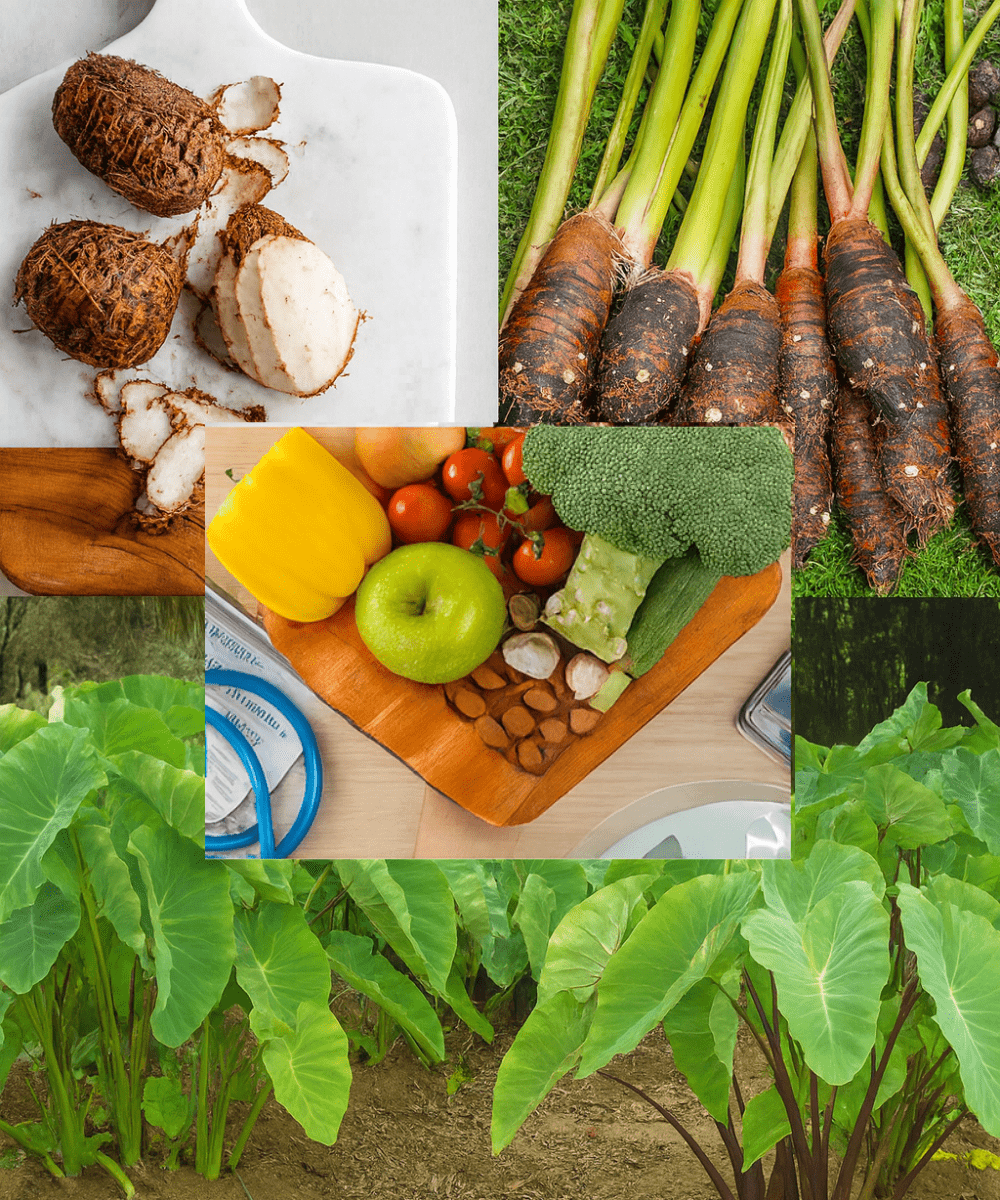🌴 Why the World’s Oldest Crop is Your Body’s New Favorite Superfood
You’ve probably seen it—the modest, brown, somewhat hairy root at the grocery store—but walked right past it. In a world obsessed with exotic, expensive wellness trends, we often miss the silent, simple power of nature’s staples. This is the story of Taro Root (Colocasia esculenta): the unassuming tuber that has served as a primary food source for over 10,000 years, nourishing entire civilizations from Africa to the South Pacific.
Taro is not just a starchy vegetable; it is a nutritional powerhouse and a true hidden gem in the modern diet. With its mild, nutty flavor and uniquely creamy, potato-like texture when cooked, taro offers a foundation of sustained energy, deep digestive comfort, and a wealth of antioxidants that can radically support your health from the inside out.

Are you searching for an affordable, gluten-free, and sustainable carb that actually supports your gut and heart? It’s time to stop overlooking this ancient star. Discover why taro is making a major comeback in wellness circles and why it deserves a permanent spot on your plate.
🔬 Taro Unraveled: The Science Behind the Starch
Known by regional names like dasheen, arbi, or cocoyam, taro is revered for its robust and complex nutritional profile. Unlike highly refined starches that cause rapid blood sugar fluctuations, taro is built for slow, sustained release—the key to its enduring global success.
📊 The Nutritional Advantage (Per One Cup Cooked):
- 🔥 High Fiber Content: Providing approximately 6.7 grams of dietary fiber, taro is a champion for intestinal health and promotes easy regularity.
- 🦠 Resistant Starch Master: A significant portion of taro’s starch is resistant starch, which acts as a powerful prebiotic. This means it bypasses digestion in the small intestine, traveling to the colon where it feeds your beneficial gut bacteria. This process is crucial for metabolic health and mood regulation.
- 💪 Mineral Density: Taro is a phenomenal source of essential minerals, including a huge boost of Potassium (around 639 mg per cup), vital for nerve function and blood pressure regulation, along with necessary Magnesium and Manganese.
- 🛡️ Antioxidant Rich: It contains potent compounds like Beta-Carotene, Cryptoxanthin, and in the case of purple varieties, Anthocyanins, all powerful antioxidants that fight cellular damage.
The takeaway is simple: taro delivers filling, functional nutrition without the inflammatory risks associated with heavily processed, low-fiber starches.
🌟 The Full Spectrum: 15 Health Benefits of Making Taro a Staple
The holistic benefits of adding properly cooked taro to your diet extend far beyond basic caloric energy. Here is a deep dive into the 15 ways this root supports your body’s health and resilience:
Part 1: Digestive & Metabolic Harmony
- ✅ Boosts Digestion & Relieves Constipation: The high fiber content adds bulk to stools, easing passage and supporting routine regularity, providing immense gut comfort.
- 📉 Supports Healthy Blood Sugar Balance: Thanks to its complex carbohydrates and high fiber, taro has a low glycemic index. This means it digests slowly, preventing the sharp blood sugar spikes that lead to energy crashes and fatigue.
- 🦠 Nourishes the Gut Microbiome: Its abundant resistant starch is the perfect fuel source for the beneficial bacteria in your colon, fostering a healthy, diverse gut flora—a foundational element of overall wellness.
- ⚖️ Aids in Weight Management: The combination of fiber and complex starch keeps you feeling fuller for much longer after a meal, naturally curbing overeating and reducing the urge to snack on processed foods, supporting healthy calorie management.
Part 2: Cardiovascular and Circulatory Health
- ❤️ Protects Heart Health: The massive concentration of Potassium helps the body regulate fluid balance and counteract the negative effects of sodium, which is essential for maintaining healthy blood pressure levels.
- 🧪 Supports Healthy Cholesterol Levels: The dietary fiber in taro assists in binding to cholesterol in the digestive system, preventing its absorption and contributing to overall healthier lipid profiles.
- 🌿 Acts as a Gentle Diuretic: Taro may support kidney function by encouraging healthy urination and helping the body reduce unnecessary water retention, leading to better fluid balance.
Part 3: Cellular Protection and Immunity
- 🛡️ Fights Oxidative Stress: Taro is rich in antioxidants, notably Manganese and Vitamin E. These compounds actively seek out and neutralize free radicals, reducing cellular damage associated with aging and disease.
- 👁️ Supports Excellent Eye Health: It contains vital phytonutrients like Beta-carotene and Cryptoxanthin. These are powerful carotenoids that the body converts to Vitamin A, which is essential for nourishing vision and protecting eye tissue.
- 💪 Enhances Immunity: A good source of Vitamin C and various antioxidants, taro helps to fortify the immune system, strengthening the body’s natural defenses against common illnesses and infections.
Part 4: Structural and Cognitive Benefits
- 🦴 Strengthens Bones and Joints: Taro contributes essential minerals like Calcium and Magnesium. Magnesium, in particular, is vital for Vitamin D absorption and helps preserve bone density and strength over time.
- 🧠 Nourishes the Brain and Focus: The presence of Vitamin B6 (Pyridoxine) is key to energy metabolism and neurological function. It aids in the creation of neurotransmitters, supporting improved focus and stable mood.
- 😌 Reduces Chronic Inflammation: The rich concentration of polyphenols and other anti-inflammatory compounds helps calm systemic inflammation, providing relief from discomfort associated with joint or muscle pain.
- ✨ Promotes Skin Glow: Antioxidants, especially Vitamin E, are essential for skin health. They protect skin cells from environmental damage and help maintain hydration, contributing to a clearer, healthier, and more vibrant complexion.
- 🌍 Supports Sustainable Agriculture: As a resilient crop that thrives in poor soil conditions and requires less intensive farming, choosing taro is an eco-friendly choice, aligning your diet with sustainable global practices.

⚠️ The One Rule You Can Never Break: Safety First with Taro
While the benefits are extensive, there is one absolute rule handed down through generations of taro consumers: Taro must NEVER be eaten raw or undercooked.
Raw taro contains needle-like calcium oxalate crystals. These compounds are powerful irritants that will cause immediate burning, itching, and swelling in the mouth and throat.
The Solution is Simple: Cook It Right
The good news is that high heat completely neutralizes these oxalates, rendering the cooked root perfectly safe, creamy, and delicious.
Simple Steps for Safe Preparation:
- Peel Carefully: Always peel the taro completely. If you have sensitive skin, wear thin kitchen gloves while handling and peeling the raw root to prevent any dermal irritation from the surface oxalates.
- Cook Until Fork-Tender: Boil, steam, or bake the taro until it is completely soft and can be easily pierced with no resistance. This usually takes 15–25 minutes depending on the size of the pieces.
- Confirm Readiness: If any part of the taro is still hard, it requires more cooking time. Only consume when soft.
🍽️ Culinary Exploration: 5 Simple Ways to Enjoy Taro’s Goodness
Taro’s versatility means it can easily slide into your favorite recipes, replacing potatoes or refined starches with a healthier, more fiber-rich option.
- 🍟 The Crispy Taro Fry: Slice the cooked and cooled taro into sticks, toss with a little coconut oil, salt, and paprika, and air-fry or bake until golden and crispy. Serve as a superior alternative to French fries.
- 🥣 Creamy Taro Soup Base: Use cooked taro as a natural thickener. Blend it with coconut milk, vegetable broth, and spices (like ginger and turmeric) for a wonderfully creamy, gut-friendly vegetarian soup.
- 🥞 Fiber-Rich Taro Pancakes: Mash boiled taro and mix a small amount into your pancake or waffle batter before cooking. It adds moisture, richness, and a huge boost of fiber to your breakfast.
- 🍲 Savory Curry & Stew Filler: Replace potatoes or yams with cubed taro in your favorite curries, stews, or braises. It absorbs flavor beautifully and contributes a comforting, starchy texture.
- 🌿 Taro Leaf Tea (Properly Prepared): The young, tender leaves can also be consumed, but must be boiled extensively and the water discarded (check local guidelines). Sipped as a tea with a little honey, it provides a unique source of nutrients (for external, professional consumption guidance only).
✨ Final Thoughts: Embrace the Power of the Simple Root
Taro root is a testament to the fact that the most profound forms of nutrition are often found in nature’s most straightforward offerings. It has quietly sustained entire civilizations because of its unique ability to deliver sustained energy, provide essential gut support, and nourish the body with vital minerals and antioxidants.
By mastering the simple art of properly cooking this ancient root, you are not just trying a new vegetable—you are participating in a tradition of wellness that spans millennia.
Ready to start feeling the difference that a truly balanced, fiber-rich carbohydrate can make? Which taro preparation will you try for dinner tonight?






